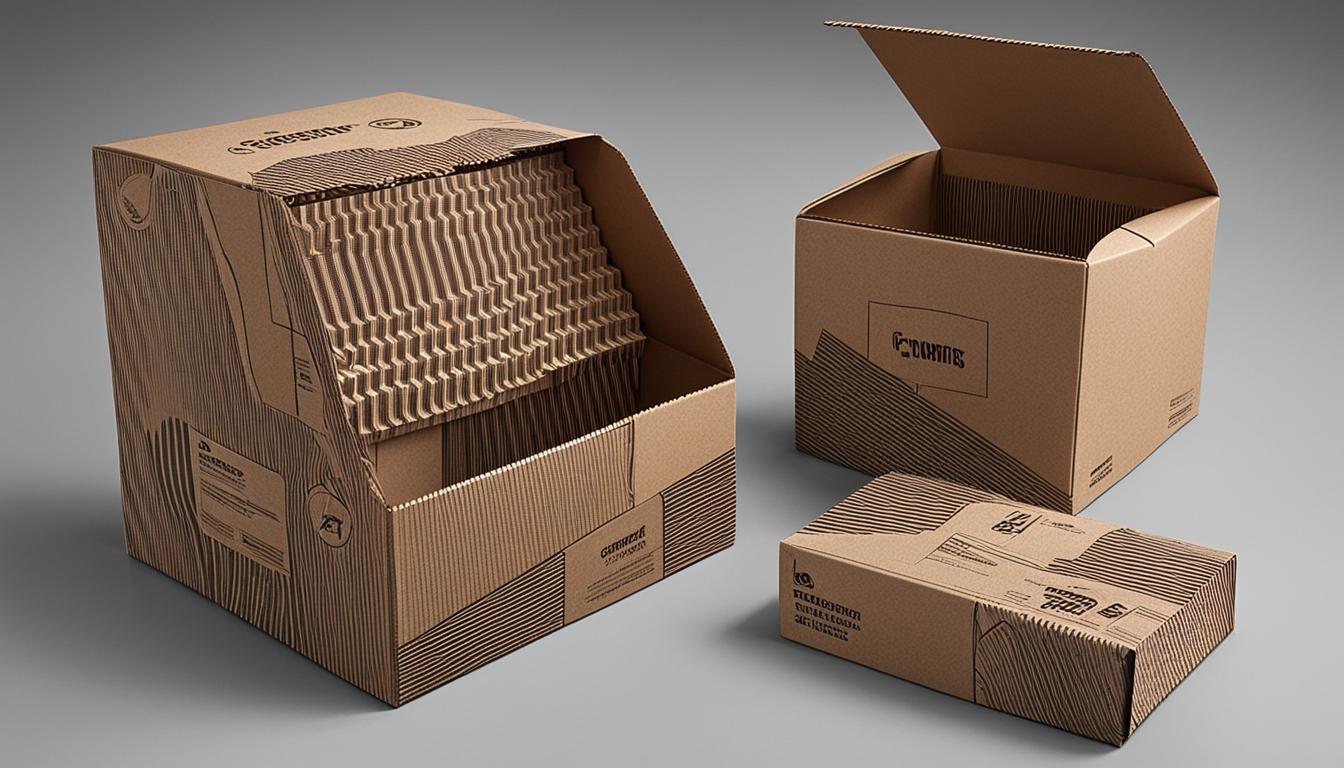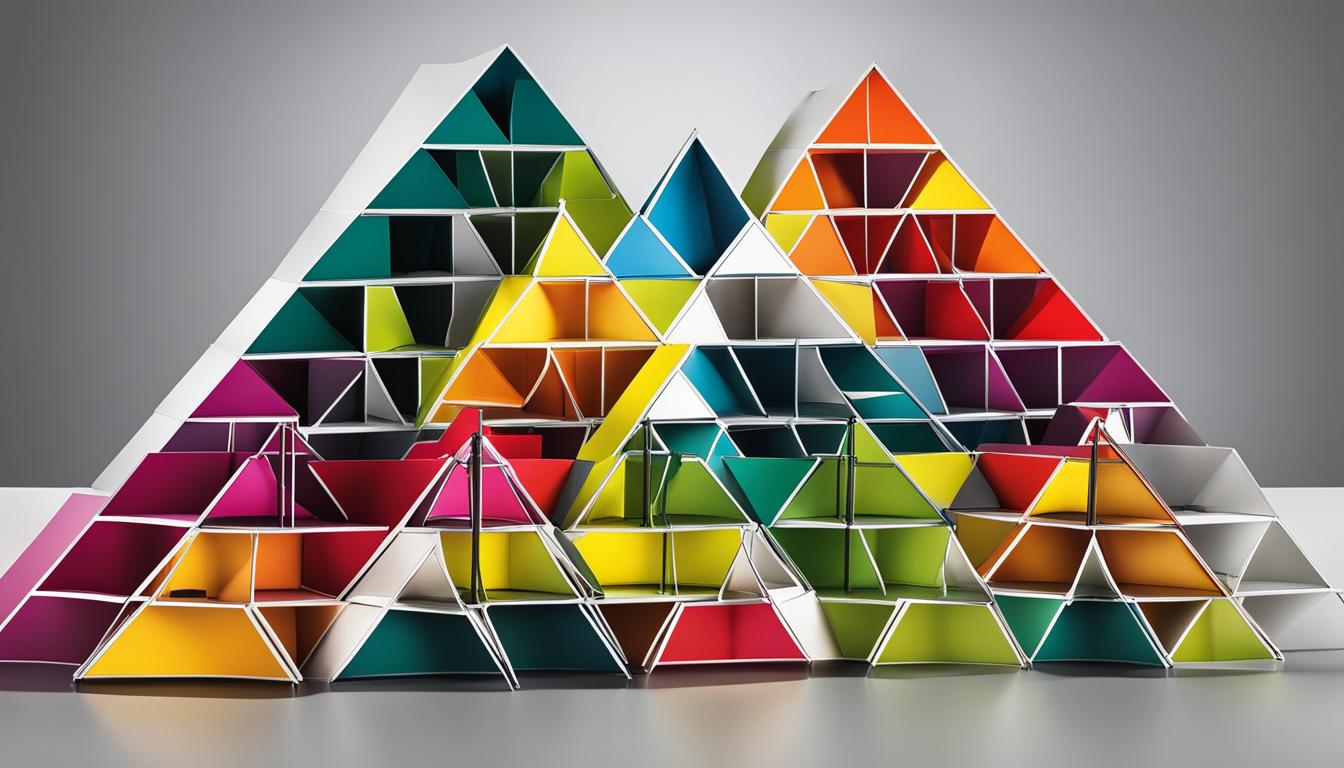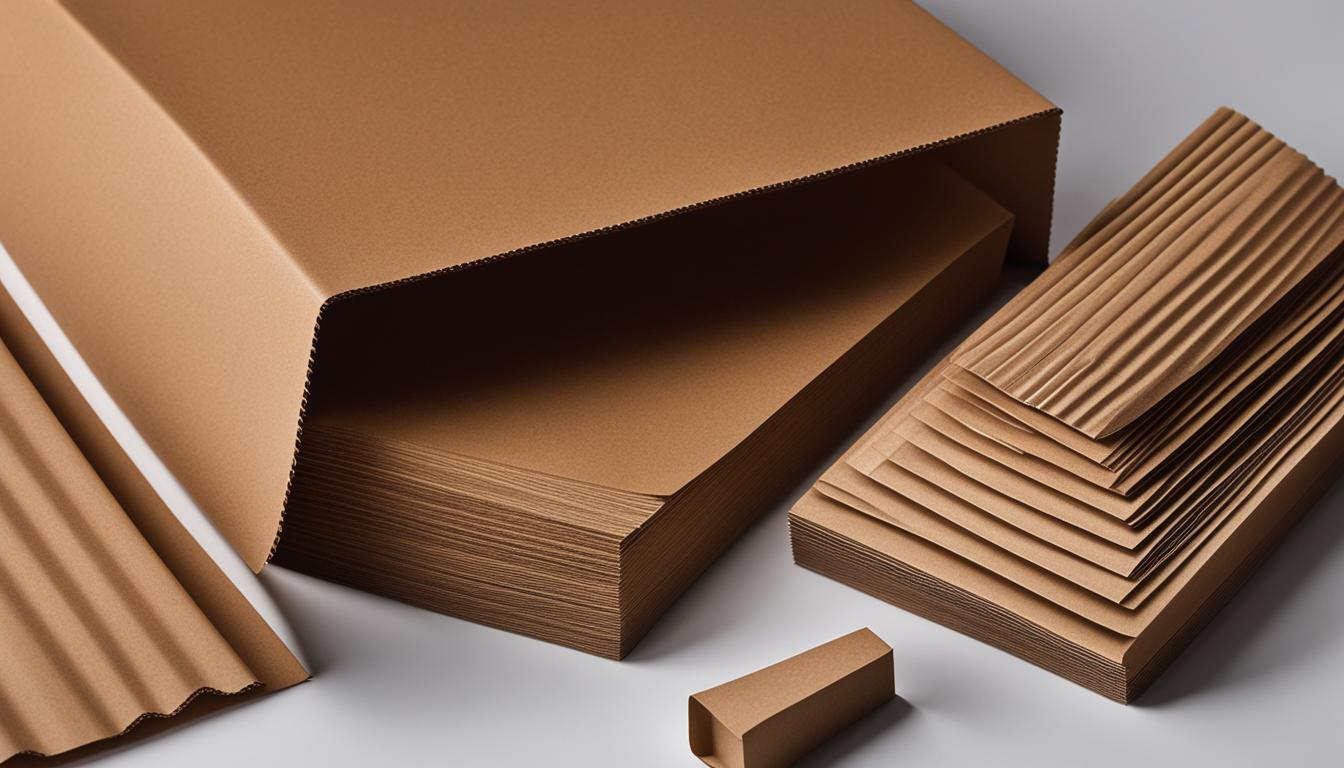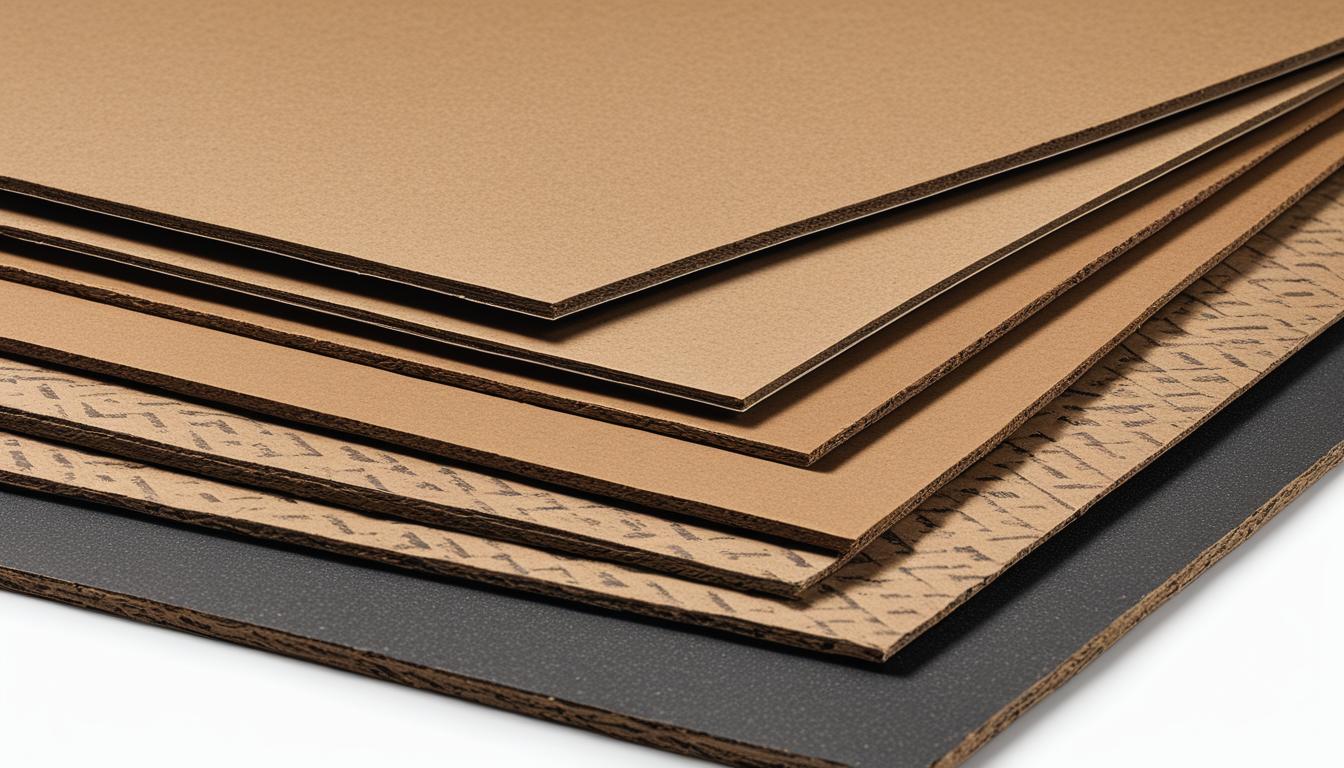The packaging of products is an essential part of commerce. To ensure the safe transport and presentation of goods, different types of cartons are used for packaging. These packaging cartons come in various materials and designs that cater to the specific needs of different industries.
In this article, I will delve into the types of cartons commonly used for packaging and explore the materials and characteristics associated with each type. By understanding the different carton packaging materials available, businesses can make informed decisions about the most suitable packaging solutions for their products.
Key Takeaways:
- There are various types of cartons used for packaging, each designed to meet specific requirements.
- The materials used in carton packaging include paperboard and cardboard, which offer different levels of strength and rigidity.
- Folding cartons are a popular choice for packaging due to their versatility, cost-effectiveness, and ease of assembly.
- Flutes in corrugated cardboard play a vital role in providing structural integrity and additional protection for packaged items.
- Understanding the GSM measurement and different wall types in carton packaging helps businesses choose the right solution for their products.
Understanding Packaging Materials: Paperboard and Cardboard
When it comes to packaging, cartons made from paperboard and cardboard are widely used for their versatility and durability. Paperboard, a thick and sturdy type of paper, is commonly employed in the production of folding cartons.
On the other hand, cardboard is crafted from layers of paper or pulp. The most prevalent form of cardboard found in packaging is corrugated cardboard, which consists of a wavy or fluted sheet of cardboard sandwiched between two flat layers. This design offers superior strength and protection for various products during transit.
| Packaging Materials | Characteristics |
|---|---|
| Paperboard | Made from thick and sturdy paper; commonly used for folding cartons |
| Cardboard | Made from layers of paper or pulp; often found in corrugated form |

Understanding the different types of packaging materials, such as paperboard and cardboard, is essential for businesses seeking suitable carton packaging solutions. By selecting the right material for their products, companies can ensure the safety and security of their goods throughout the packaging and shipping processes.
Exploring Different Types of Folding Cartons
Folding cartons are a highly versatile and widely used packaging solution in various industries. They provide convenience, protection, and visual appeal for a range of products. Let’s take a closer look at some of the different types of folding cartons and their applications.
Straight Tuck End (STE) cartons: These are the most common type of folding cartons. They feature a simple design with tuck closures on both ends, ensuring secure packaging. STE cartons are widely used for food items, cosmetics, pharmaceuticals, and more.
Reverse Tuck End (RTE) cartons: Similar to STE cartons, RTE cartons also have a tuck closure mechanism. However, the tucking ends are reversed compared to the STE cartons. These cartons provide a sleek and modern look, making them suitable for various products, including electronics, personal care items, and small appliances.
Tuck Top Auto-Bottom (TTAB) cartons: These cartons have a tuck top closure and an automatic bottom closure. The tuck top allows for easy access to the packaged product, while the automatic bottom ensures quick assembly and secure packaging. TTAB cartons are commonly used for beverages, dry goods, and household products.
“Folding cartons provide convenience, protection, and visual appeal for a range of products.”
These folding cartons offer flexibility in terms of design, size, and customization options, allowing businesses to create packaging solutions tailored to their specific needs. The cartons can be printed with branding and product information, enhancing the visual appeal and creating a cohesive brand experience.
Folding cartons are not only practical but also environmentally friendly. They can be easily recycled, contributing to sustainable packaging practices. Their lightweight nature also reduces transportation costs and carbon footprint.
| Type of Folding Carton | Applications |
|---|---|
| Straight Tuck End (STE) cartons | Food, cosmetics, pharmaceuticals |
| Reverse Tuck End (RTE) cartons | Electronics, personal care items, small appliances |
| Tuck Top Auto-Bottom (TTAB) cartons | Beverages, dry goods, household products |

With their versatility, durability, and eco-friendliness, folding cartons continue to be a go-to choice for businesses looking for effective packaging solutions. They not only provide practical benefits but also serve as an opportunity to elevate the brand image and enhance customer satisfaction.
Understanding Paper Types in Packaging
When it comes to packaging, the type of paper used plays a crucial role in determining the strength and printability of cardboard. In this section, we will explore two main types of paper used in packaging: Kraft paper and test liners.
Kraft paper is made from virgin softwood trees, which give it exceptional strength and durability. This type of paper is also known for its ability to withstand heavy loads and resist tearing. Additionally, Kraft paper has excellent printability, allowing for vibrant and high-quality graphics to be applied to packaging.
Test liners, on the other hand, are made from recycled paper. While they are less strong compared to Kraft paper, they still provide sufficient support for many packaging applications. However, test liners are not ideal for printing as the surface may not be as smooth, limiting the quality of graphics that can be displayed.
To harness the benefits of both types of paper, they are often laminated together to create the layers of cardboard used in packaging. The combination of Kraft paper’s strength and printability with the cost-effective and eco-friendly nature of test liners results in a versatile and reliable packaging material.

The Role of Flutes in Corrugated Cardboard
Flutes are an integral part of corrugated cardboard, providing crucial structural support. They consist of wavy layers sandwiched between two flat layers of cardboard, creating a sturdy and versatile packaging material. Corrugated cardboard flutes come in different sizes, each offering unique properties and strengths:
- A Flute: The largest flute size, A flute offers excellent cushioning and is often used for fragile items that require extra protection.
- B Flute: The most common flute size, the B flute provides a good balance between cushioning and stacking strength, making it versatile for various packaging applications.
- C Flute: With a smaller flute height, the C flute provides greater stiffness and durability. It is commonly used for heavy-duty packaging and display stands.
- E Flute: The smallest flute size, the E flute is ideal for applications that require intricate printing or a compact packaging design.
By combining different flute sizes, manufacturers can create double-walled or even triple-walled cardboard, further increasing the strength and protection of the packaging. This is especially beneficial for shipping heavy or delicate items over long distances.

Understanding Grams per Square Meter (GSM) in Cardboard
The thickness of cardboard is often measured in Grams per Square Meter (GSM). GSM refers to the weight of the paper used to make the cardboard, and it affects the strength and rigidity of the final product. A higher GSM indicates a thicker and heavier cardboard.
The GSM measurement is often indicated as a combination of values, such as 135/155K, where the first value represents the inner liner GSM and the second value represents the outer liner GSM.
| GSM Measurement | Cardboard Thickness |
|---|---|
| 135/155K | Thicker and heavier cardboard |
| 85/100N | Thinner and lighter cardboard |

Understanding the GSM measurement is important when choosing the right cardboard thickness for packaging. It ensures that the cardboard provides the necessary strength and protection for the products being packaged. It is essential to consider the weight and fragility of the items to be packaged when selecting the appropriate GSM value.
Exploring Wall Types in Packaging
When it comes to packaging, choosing the right wall type is essential to ensure the protection and integrity of your products. Cardboard used in packaging can be categorized into different wall types, each offering varying levels of strength and protection. Let’s take a closer look at the three main types: single-walled cardboard, double-walled cardboard, and triple-walled cardboard.
Single-Walled Cardboard
Single-walled cardboard consists of a single layer of fluted cardboard sandwiched between two layers of flat cardboard. This type of cardboard is lightweight and suitable for packaging lightweight or less fragile items. It provides basic protection and is commonly used for products such as consumer electronics, toys, and small appliances.
Double-Walled Cardboard
Double-walled cardboard, as the name suggests, consists of two layers of fluted cardboard between three layers of flat cardboard. This type of cardboard offers enhanced durability and strength compared to single-walled cardboard. It provides better protection for heavier or more delicate items during shipping and handling. Double-walled cardboard is commonly used for items like furniture, large appliances, and electronic equipment.
Triple-Walled Cardboard
Triple-walled cardboard is the strongest and most durable type of cardboard used in packaging. It consists of three layers of fluted cardboard sandwiched between four layers of flat cardboard. Triple-walled cardboard provides maximum strength and protection, making it suitable for extremely heavy or fragile items that require superior structural integrity. It is commonly used in industries such as automotive, industrial equipment, and construction.
By understanding the different wall types in packaging, you can choose the appropriate cardboard material that meets the specific requirements of your products. Whether you need basic protection, enhanced durability, or maximum strength, selecting the right wall type is crucial to ensure your products arrive safely at their destination.

Understanding Carton Construction and Abbreviations
When it comes to carton packaging, corrugated board construction is the most commonly used method. It involves combining fluted cardboard with flat layers of cardboard to create a sturdy and versatile packaging material. This construction technique provides excellent strength and protection for a wide range of products.
To describe the construction of a corrugated board, abbreviations are used. For example, let’s consider the abbreviation 125K/E/125T. Here, the number 125 represents the outer liner GSM (Grams per Square Meter), the letter E indicates the type of fluting, and the second 125 denotes the inner liner GSM. These abbreviations vary depending on the specific properties and uses of the cardboard being described.
By combining different liner GSM values and fluting types, manufacturers can create custom cardboard solutions tailored to meet specific requirements. This flexibility allows for the production of corrugated boards with varying levels of strength, rigidity, and durability to suit different packaging needs.
Example Abbreviation:
125K/E/125T
Table: Properties of Different Liner GSM Values and Fluting Types
| Liner GSM | Fluting Type | Properties |
|---|---|---|
| 125 | A | Lightweight, suitable for lightweight products and printing |
| 150 | B | Moderate strength, used for various general packaging applications |
| 200 | C | Enhanced strength, ideal for heavy-duty packaging and protection |
The table above showcases some examples of liner GSM values combined with different fluting types and their corresponding properties. It’s important to note that these values can vary depending on individual manufacturer specifications and requirements.
Understanding carton construction and abbreviations in packaging is essential for businesses to make informed choices about the most suitable materials for their specific products. Corrugated board, with its various liner GSM values and fluting types, offers versatility, strength, and customization options to meet a wide range of packaging needs.
Common Uses of Different Fluting Sizes
Fluting sizes in cardboard play a significant role in packaging, providing specific advantages for different applications. Understanding the uses of fluting sizes can help businesses choose the appropriate cardboard for their packaging needs.
B Flute
B flute is the most commonly used fluting size in cardboard packaging. It offers a good balance between strength and printability, making it suitable for a wide range of products. B flute is often used for mailer boxes, display stands, and retail packaging.
C Flute
C flute provides enhanced crash protection, making it ideal for moving and shipping boxes. It offers greater stacking strength and increased resistance to impact and compression. C flute is commonly used for packaging fragile and delicate items, electronics, and glassware.
E Flute
E flute is the thinnest type of corrugated cardboard and is known for its excellent printability. Its fine flute structure offers a smooth surface, making it suitable for high-quality graphics and intricate designs. E flute is commonly used for packaging luxury products, cosmetics, and consumer electronics.
Combining Flutes for Optimal Solutions
In addition to individual fluting sizes, flutes can be combined to create optimal packaging solutions. For example, the EB flute combines the strength of the E flute with the durability of the B flute, providing a balance of strength and printability. This combination is often used for packaging items that require both protection and visual appeal.
Choosing the right fluting size ensures that packaging meets the specific requirements of the product, balancing strength, printability, and protection. By understanding the common uses of different fluting sizes, businesses can make informed decisions when selecting cardboard for their packaging needs.
Benefits of Folding Cartons for Packaging
Folding cartons offer several advantages for packaging. Let’s explore the benefits of using folding cartons:
- Versatility: Folding cartons can be used for a wide range of products across various industries, including food, cosmetics, pharmaceuticals, and more.
- Cost-effectiveness: Folding cartons are affordable and provide a cost-effective packaging solution, especially for businesses with large-scale production needs.
- Environmentally friendly: Folding cartons are made from sustainable materials, such as paperboard and cardboard, making them eco-friendly and easily recyclable.
- Customization: Folding cartons can be easily customized with various finishing options, such as embossing, foil stamping, and spot UV, allowing businesses to create unique packaging designs that reinforce their brand identity.
- Easy assembly and storage: Folding cartons are designed for easy assembly, stacking, and storage, optimizing space and simplifying the packing process.
- Product protection: Folding cartons provide excellent protection for the packaged products, keeping them safe from damage during transit and storage.
- Branding opportunities: Folding cartons offer ample space for branding elements, including logos, product information, and promotional messages, helping businesses enhance their brand visibility and create a memorable unboxing experience for customers.
- Consumer convenience: Folding cartons are consumer-friendly, featuring user-friendly closures and easy opening mechanisms, ensuring a hassle-free experience for end-users.
Overall, the advantages of folding cartons make them a preferred choice for businesses looking for versatile, cost-effective, and environmentally friendly packaging solutions.
Customer Testimonial: A Successful Case Study
“We switched to folding cartons for our cosmetic products and witnessed a significant boost in sales. The visually appealing packaging and customization options helped us stand out on the shelves, attracting more customers. The easy assembly and storage also streamlined our packing process, saving us time and money. We highly recommend folding cartons for businesses seeking effective packaging solutions.”
– Lisa Thompson, CEO of CosmetiCraft
| Advantages of Folding Cartons | Reasons |
|---|---|
| Versatility | Suitable for various industries and products |
| Cost-effectiveness | Affordable packaging solution |
| Environmentally friendly | Made from sustainable materials |
| Customization | Allows for unique branding and design options |
| Easy assembly and storage | Saves time and optimizes space |
| Product protection | Ensures safe transportation and storage |
| Branding opportunities | Enhances brand visibility and recognition |
| Consumer convenience | User-friendly and easy to open |
Packaging Materials Conclusion
When it comes to packaging, the materials used play a crucial role in both protecting the products and enhancing the overall packaging experience. Paperboard and cardboard are two commonly used materials that offer a range of benefits.
Paperboard is a thick and sturdy paper that is often used for folding cartons. Its strength and printability make it a versatile choice for packaging various products. On the other hand, cardboard is made from layers of paper or paper pulp and is commonly used for corrugated packaging materials. It provides strength, durability, and customization options.
Understanding the different types of folding cartons, such as the Straight Tuck End (STE), Reverse Tuck End (RTE), and Tuck Top Auto-Bottom (TTAB) cartons, allows businesses to choose the most suitable design for their specific needs.
Moreover, being aware of the various paper qualities, flutes, construction abbreviations, and uses of fluting sizes can help businesses make informed decisions when selecting packaging solutions. These factors contribute to the strength, rigidity, and protection provided by the packaging materials.
Folding cartons, in particular, offer numerous benefits that make them a popular choice across various industries. Their versatility, cost-effectiveness, and eco-friendliness make them favorable options for businesses. Additionally, folding cartons can be easily customized with various finishing options and graphic designs, allowing brands to create eye-catching packaging that reflects their identity and attracts consumers.
Overall, the proper selection and utilization of packaging materials, such as cartons, contribute significantly to the success of products in the market. By understanding the different types of cartons, their materials, and their benefits, businesses can make informed decisions and create packaging solutions that not only protect their products but also enhance brand reputation and consumer satisfaction.
In conclusion, the thoughtful selection of packaging materials is essential for businesses aiming to deliver their products securely and achieve a positive customer experience. Paperboard and cardboard provide strength, versatility, and customization options. Understanding the different types of folding cartons, paper qualities, flutes, construction abbreviations, and uses of fluting sizes empowers businesses to make smart choices when determining their packaging solutions. Folding cartons offer numerous benefits, making them a favored option across various industries.
Conclusion
After a comprehensive exploration of the different types of cartons used for packaging, it becomes evident that businesses have a wide range of options to choose from. Folding cartons, such as the Straight Tuck End (STE), Reverse Tuck End (RTE), and Tuck Top Auto-Bottom (TTAB) cartons, offer diverse designs and closures that cater to various packaging needs.
To make informed decisions for protecting products and optimizing storage and shipment, it is essential to understand the materials, construction, flutes, and wall types involved in packaging. This knowledge empowers businesses to select the most suitable cartons and packaging materials for their specific requirements.
By considering the insights from reputable sources, including the First Source, Second Source, and Third Source, businesses can ensure they are leveraging different types of cartons used for packaging, various packaging box types, and different types of packaging materials to their advantage. Ultimately, this will lead to improved product protection, efficient shipping, and enhanced customer satisfaction.
FAQ
What are the different types of cartons used for packaging?
The different types of cartons used for packaging include folding cartons and rigid cartons. Folding cartons are made from a single sheetboard and are commonly used for items like pizza boxes. Rigid cartons, also known as telescopic cartons, have separate top and bottom parts made from sturdy cardboard and are used for products with greater perceived value or that are heavy and require extra care.
What materials are commonly used for carton packaging?
Cartons used for packaging are commonly made from paperboard or cardboard. Paperboard is a type of thick, sturdy paper often used for folding cartons, while cardboard is made from layers of paper or paper pulp. Corrugated cardboard is the most common type of cardboard used in packaging and is formed by a wavy/fluted sheet of cardboard sandwiched between two flat layers.
What are the different types of folding cartons?
The different types of folding cartons include the Straight Tuck End (STE) carton, the Reverse Tuck End (RTE) carton, and the Tuck Top Auto-Bottom (TTAB) carton. These cartons have different designs and closures suited for various applications.
What types of paper are used in carton packaging?
The paper used for making cardboard can be categorized into two types: Kraft paper and test liners. Kraft paper is made from virgin softwood trees and is known for its strength and printability. Test liners, on the other hand, are made from recycled paper and are less strong and less suitable for printing.
What is the role of flutes in corrugated cardboard?
Flutes are the wavy part of corrugated cardboard and play a vital role in its structural integrity. They come in different sizes, such as A, B, C, and E flutes, with each size offering different properties and strengths. Flutes can be combined to create double-walled or triple-walled cardboard, providing additional protection for heavy or delicate items during shipping.
How is the thickness of cardboard measured?
The thickness of cardboard is often measured in Grams per Square Meter (GSM). GSM refers to the weight of the paper used to make the cardboard, and it affects the strength and rigidity of the final product. A higher GSM indicates a thicker and heavier cardboard.
What are the different wall types in packaging?
The cardboard used in packaging can be categorized into different wall types. Single-walled cardboard consists of a single layer, while double-walled cardboard has two layers of fluted cardboard between three layers of flat cardboard. Triple-walled cardboard has three layers of fluted cardboard between four layers of flat cardboard.
What do the abbreviations in carton packaging represent?
The construction of corrugated board can be described using abbreviations, such as 125K/E/125T. This abbreviation represents the outer liner GSM (125), fluting type (E), and inner liner GSM (125T).
What are the common uses of different fluting sizes in cardboard?
Fluting sizes in cardboard have specific uses in packaging. The b flute is often used for mailer boxes, the C flute offers better crash protection and is commonly used in moving and shipping boxes, and the E flute is suitable for printing. Flutes can be combined to create optimal packaging solutions, such as EB flutes for a balance of strength and printability.
What are the benefits of folding cartons for packaging?
Folding cartons offer several advantages for packaging. They are versatile, cost-effective, and environmentally friendly. They can be customized with various finishing options and graphic designs. Folding cartons are easy to assemble, stack, and store, optimizing storage and shipment. They provide product protection, branding opportunities, and consumer convenience.
Why are packaging materials important for businesses?
Packaging materials, including different types of cartons, play a crucial role in protecting products and enhancing the overall packaging experience. Paperboard and cardboard are commonly used materials, offering strength, versatility, and customization options. Understanding the different types of cartons and packaging materials can help businesses make informed decisions when choosing packaging solutions.
What is the conclusion about the types of cartons used for packaging?
Cartons used for packaging come in different types and materials. Folding cartons and rigid cartons are commonly used for various applications. Paperboard and cardboard are the primary materials used, with corrugated cardboard being the most common type of cardboard. Understanding the different types of cartons and packaging materials is important for businesses to make informed decisions.

